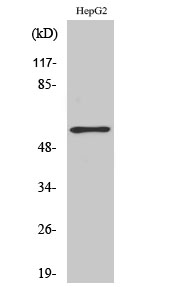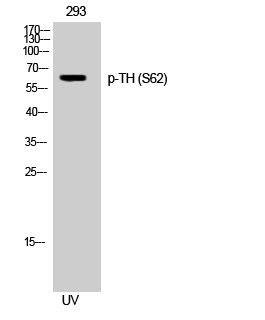
Catalog: KA1190C
Size
Price
Status
Qty.
96well
$470.00
In stock
0
Add to cart


Collected


Collect
Main Information
Reactivity
Human, Mouse, Rat
Applications
ELISA
Conjugate/Modification
Phospho
Detailed Information
Storage
2-8°C/6 months,Ship by ice bag
Modification
Phospho
Detection Method
Colorimetric
Related Products
Antigen&Target Information
Gene Name:
TH
show all
Other Name:
Tyrosine 3-monooxygenase ;
Tyrosine 3-hydroxylase ;
TH ;
Tyrosine 3-hydroxylase ;
TH ;
show all
Background:
catalytic activity:L-tyrosine + tetrahydrobiopterin + O(2) = 3,4-dihydroxy-L-phenylalanine + 4a-hydroxytetrahydrobiopterin.,cofactor:Fe(2+) ion.,disease:Defects in TH are the cause of dystonia DOPA-responsive autosomal recessive (ARDRD) [MIM:605407]; also known as autosomal recessive Segawa syndrome. ARDRD is a form of DOPA-responsive dystonia presenting in infancy or early childhood. Dystonia is defined by the presence of sustained involuntary muscle contractions, often leading to abnormal postures. Some cases of ARDRD present with parkinsonian symptoms in infancy. Unlike all other forms of dystonia, it is an eminently treatable condition, due to a favorable response to L-DOPA.,enzyme regulation:Phosphorylation leads to an increase in the catalytic activity.,function:Plays an important role in the physiology of adrenergic neurons.,online information:Tyrosine hydroxylase entry,pathway:Catecholamine biosynthesis; dopamine biosynthesis; dopamine from L-tyrosine: step 1/2.,similarity:Belongs to the biopterin-dependent aromatic amino acid hydroxylase family.,tissue specificity:Mainly expressed in the brain and adrenal glands.,
show all
Function:
regulation of neurotransmitter levels, eye development, response to hypoxia, eye photoreceptor cell differentiation,synaptic transmission, dopaminergic, heart morphogenesis, tyrosine metabolic process, cellular amino acid derivative metabolic process, biogenic amine metabolic process, catecholamine metabolic process, dopamine biosynthetic process from tyrosine, cell-cell signaling, synaptic transmission, nerve-nerve synaptic transmission, sensory organ development, heart development, sensory perception, visual perception, behavior, learning or memory, learning,memory, mating behavior, mating, locomotory behavior, feeding behavior, regulation of heart contraction, aromatic amino acid family metabolic process, amine biosynthetic process, catechol metabolic process, response to endogenous stimulus, response to hormone stimulus, response to organic substance, phenol metabolic process, reproductive behavior, transmission of nerve impulse, neuron differentiation, embryonic camera-type eye development, diol metabolic process, neurotransmitter metabolic process, neurotransmitter biosynthetic process, cellular amino acid derivative biosynthetic process, biogenic amine biosynthetic process, epinephrine metabolic process, norepinephrine metabolic process, dopamine biosynthetic process, dopamine metabolic process, epinephrine biosynthetic process,norepinephrine biosynthetic process, catecholamine biosynthetic process, photoreceptor cell development, eye photoreceptor cell development, eating behavior, camera-type eye development, pigmentation, regulation of system process, nitrogen compound biosynthetic process, response to ethanol, photoreceptor cell differentiation, embryonic eye morphogenesis, response to steroid hormone stimulus, embryonic organ morphogenesis, embryonic organ development, eye morphogenesis, camera-type eye morphogenesis, embryonic camera-type eye morphogenesis,embryonic morphogenesis, neuron development, neurological system process, cognition, sensory perception of light stimulus, behavioral interaction between organisms, oxidation reduction, response to oxygen levels,
show all
Cellular Localization:
Cytoplasm, perinuclear region . Nucleus . Cell projection, axon . Cytoplasm . Cytoplasmic vesicle, secretory vesicle, synaptic vesicle . When phosphorylated at Ser-19 shows a nuclear distribution and when phosphorylated at Ser-31 as well at Ser-40 shows a cytosolic distribution (By similarity). Expressed in dopaminergic axons and axon terminals. .
show all
Tissue Expression:
Signaling Pathway
Reference Citation({{totalcount}})
Catalog: KA1190C
Size
Price
Status
Qty.
96well
$470.00
In stock
0
Add to cart


Collected


Collect
Recently Viewed Products
Clear allPRODUCTS
CUSTOMIZED
ABOUT US
Toggle night Mode
{{pinfoXq.title || ''}}
Catalog: {{pinfoXq.catalog || ''}}
Filter:
All
{{item.name}}
{{pinfo.title}}
-{{pinfo.catalog}}
Main Information
Target
{{pinfo.target}}
Reactivity
{{pinfo.react}}
Applications
{{pinfo.applicat}}
Conjugate/Modification
{{pinfo.coupling}}/{{pinfo.modific}}
MW (kDa)
{{pinfo.mwcalc}}
Host Species
{{pinfo.hostspec}}
Isotype
{{pinfo.isotype}}
Product {{index}}/{{pcount}}
Prev
Next
{{pvTitle}}
Scroll wheel zooms the picture
{{pvDescr}}









.jpg)









